Tombow Cool Mechanical Pencil Review
Over the past few years I have become increasingly aware of just how much the offerings of the global writing instrument brands vary from one country to another. I guess ages ago I had a rather naïve and simplistic view of the global brands, something along the lines of the brand having a basket of products with a sort of pick and mix selection of those products being offered in various countries or geographical regions by the relevant national distributors. These days my view is more along the lines of the global brand having a basket of products, as well as the various national distributors each having their own individual baskets, such that the products offered in any one country are a selection from the global basket plus the contents of the local basket.
Although it is far away on the other side of the world, Turkey is an inextricable and visceral part of one of the
most important events in the history of my country, and that of our
‘Trans-Tasman Cousins’. So, unusual connections to Turkey have a little extra interest for me. There are writing instrument manufacturers in Turkey, one of which is
ADEL, a joint venture between Anadolu Group of Turkey and Germany’s Faber-Castell, but I haven’t as yet got my hands on any of their products. Today though I have something else of interest - it appears that there are some Turkey-only Tombow mechanical pencils. You can see them
here at the website of Serve, who are an office supplies company in Turkey, and in particular a (or the) Turkish distributor for Tombow of Japan.
So, from Turkey, I present the Tombow Cool. According to the Serve website (with the assistance of Google translate, and as far as I can understand it) the Tombow Cool mechanical pencil is available in seven colour options and in 0.5, 0.7 and 0.9mm lead. Mine is the metallic grey colour and 0.9mm lead.
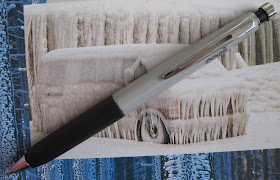
First off then, does the Tombow Cool look cool? Well I quite like its looks, and the Cool logo printed on the body does look rather cool. The combination of black, metallic grey and chrome blends nicely.
The Cool is a triangular bodied mechanical pencil. The rubber grip is triangular and feels a little wider than average. It is quite long in length, taking up over a third of the length of the pencil so you can pretty much hold the Cool wherever you like – down low close to the tip or way up for that relaxed stance.

The rubber is smooth without any surface pattern and a reasonably grippy compound with a small amount of give under finger pressure. The Cool is reasonably lightweight and neutrally balanced so it doesn’t have a lot of presence in the hand.
The tip section is a chrome metal cone, and the retractable lead sleeve is also a short cone so this pencil is pocket safe but clearly intended as a general writing pencil. The mechanism is a standard push top ratchet. For my 0.9mm version, ten clicks will get you 7mm of lead. The mechanism feels and sounds nice, smooth and positive.

Up at the top end of the pencil, the push top button is an extendable eraser housing. I quite like the grooved chrome ring around the housing.

The eraser core itself is a fairly hard white plastic or TPR and is about 4mm diameter. You can twist out about 26mm (1”) of usable length. The eraser is obviously replaceable.

The entire cartridge pulls out to allow access to the lead refill magazine.

The pocket clip is very smart looking. It is rather strongly sprung, almost too strong. It certainly won’t be accidently slipping off whatever you clipped it to.
Markings on the body are minimal – “Cool” up by the pocket clip, and “09, Tombow, Japan” down near the rubber grip.


Overall then this is a nice smart looking mechanical pencil and quite reasonably priced. It’s unusual origins are a little added bonus to mechanical pencil collectors. Cool is not an inappropriate name.
- Best Points – The looks.
- Not So Good Points – Nothing really leaps out at me.
- Price Range – Economy/Low.
- Does this pencil make it into the Top 5? - No.
Dimensions – Length 145mm, triangle sides about 11mm. Balance point about 70mm up from the tip.
PS – if there are any collectors or regular readers out there from Turkey, it would be great to hear from you – send me an email on the address up in the blog header.
 Mini eraser under the end section.
Mini eraser under the end section. 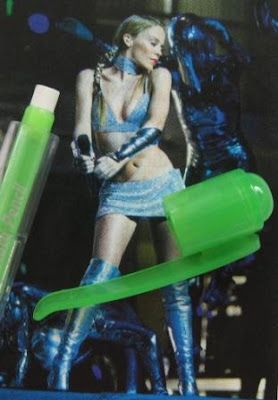 The Mini is 114mm long with the sleeve retracted, and the rubber grip is 11mm diameter at its widest point.
The Mini is 114mm long with the sleeve retracted, and the rubber grip is 11mm diameter at its widest point.



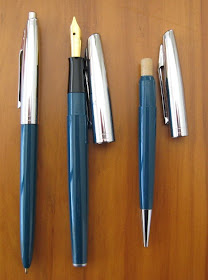
 At a quick glance the High Grade and the Original Kuru Toga don’t share many components other than the name and presumably the same internal Kuru Toga “turn engine” mechanism. You can see the differences in the pictures below.
At a quick glance the High Grade and the Original Kuru Toga don’t share many components other than the name and presumably the same internal Kuru Toga “turn engine” mechanism. You can see the differences in the pictures below.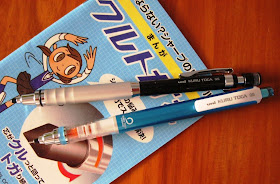





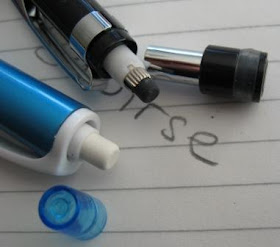



 As you can see the box states they are model W610 pencils, and cost 29cents. The fine print mentions both Scripto USA and Canada, so maybe back in the day they were 29cents in both countries? I suppose 29cents got you one pencil rather than one boxful as the fine print states, “To display: Separate at perforation and discard top”. I can’t see any perforations anywhere…
As you can see the box states they are model W610 pencils, and cost 29cents. The fine print mentions both Scripto USA and Canada, so maybe back in the day they were 29cents in both countries? I suppose 29cents got you one pencil rather than one boxful as the fine print states, “To display: Separate at perforation and discard top”. I can’t see any perforations anywhere… The pencils are very basic. You twist the top knob around to advance the lead, and it’s obviously intended as a propel-only screw mechanism, although you can wind backwards and then force the lead back up inside. I assume it was meant to be a disposable mechanical pencil and that you cannot refill the lead once it is all used up.
The pencils are very basic. You twist the top knob around to advance the lead, and it’s obviously intended as a propel-only screw mechanism, although you can wind backwards and then force the lead back up inside. I assume it was meant to be a disposable mechanical pencil and that you cannot refill the lead once it is all used up.  The lead itself is not a graphite lead, rather it is some sort of waxy crayon type lead, roughly about 3mm diameter. It is a good dark black colour. I guess this pencil was sold for durably marking difficult surfaces, an alternative to today’s felt tip markers?
The lead itself is not a graphite lead, rather it is some sort of waxy crayon type lead, roughly about 3mm diameter. It is a good dark black colour. I guess this pencil was sold for durably marking difficult surfaces, an alternative to today’s felt tip markers?











 Lamy head office & factory
Lamy head office & factory Factory and roof garden sculpture
Factory and roof garden sculpture